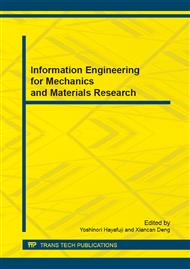[1]
Zheng, R.F., The salting mechanism and processing methods of salted egg. Farm Products Processing(05),2009,pp.24-25.
Google Scholar
[2]
Li, S.J. & Ling, G., A quick method for salted duck eggs and its quality improvement. Science and Technology of Food Industry 27(2) 2006, pp.95-96: 100.
Google Scholar
[3]
Chi, S.P. & Tseng, K.H., Physicochemical, properties of salted pickled yolk from duck and chicken eggs. Food Science 33, 1998, pp.507-513.
DOI: 10.1111/j.1365-2621.1998.tb15668.x
Google Scholar
[4]
Xu, M.S. & Dong, K.F. & Yan, J.F. , The In fluence of the Spices on the Quality of Salted Egg. Meat Researc(4), 2000, pp.38-39.
Google Scholar
[5]
Liu, L.Z. &Wen, Y.X. & Zhang, S.H. et. , The influence of various food additives and natural spices on the process of salted eggs. Science and Technology of Food Industry(01), 2003, pp.48-50.
Google Scholar
[6]
Zeng, Z. & Ma, M.H. & He, L. et., Effect of Different Pickle Additives on Preserved Salted Egg. Journal of Chinese Institute of Food Science and Technology(10), 2013, pp.140-148.
Google Scholar
[7]
Pu, Y.J. &Du, J.P. &Liang, Z.H., Study on Processing of Salted Egg with Circulating Water . China Poultry, (16), 2010, pp.25-27.
Google Scholar
[8]
Chen, S.T. & Gao, Z.J., Study on the process of salted eggs under pulsed pressure. Transactions of the Chinese Society of Agricultural Engineering(S2), 2006, pp.163-166.
Google Scholar
[9]
Wang, X.T. &Gao, Z.J. , Orthogonal Array Design for Optimization of Pulse Pressure Processing of Salted Eggs[J]. Food Science(08), 2010, pp.97-101.
Google Scholar
[10]
Zheng, Y.Q. & Liu, S.T. & Chen, G.R., The applications and the preliminary mechanisms of ultrasonic technology in aalting Eggs. Journal of Fuzhou University (Natural Science Edition)(03), 1996 , pp.73-76.
Google Scholar
[11]
Lai, Y.P. & Lin, X.Y. & Zhu R.B., Application of ultrasonic technology in production of salted eggs. Food and Machinery(01), 2011, pp.134-135.
Google Scholar
[12]
Liu, G.Q. & Jiang, L. & Qian, X.Y., Optimization of Processing Technology of Salted Duck Eggs. Food Science(12), 2008, pp.234-237.
Google Scholar
[13]
Wang, S.Q. & Wang, S.C. &Ma, M.H., Design of the Highly Active Salting Egg Can's Control System Based on ARM. IEEE Computer Society, 2011, pp.2991-2994.
Google Scholar
[14]
Wang, J. &Han, T. &Li, P., Study and Applications of Ultrasound Wave in Biological and Food Technology. Journal of Beijing Agricultural College(01), 2006, pp.67-75.
Google Scholar
[15]
Ron, J.H. & Zhang, Z.M. & Feng, L., Pickling dynamics of salted eggs. Pickling dynamics of salted eggs(02), 2007,pp.263-266.
Google Scholar


